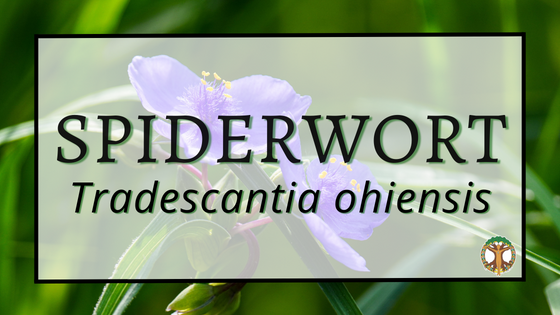
Spiderwort
Latin name: Tradescantia ohiensis – Commelinaceae
Common name: Spiderwort, bluejacket, Ohio spiderwort, day flower, Widow’s Tears, Spider lily
Varieties: T. ohiensis is most common throughout North and Central Florida, while T. hirsutiflora is found throughout the Panhandle. T. virginia is another common variety found outside of Florida and a popular search result when looking for information regarding “Spiderwort” on the internet. However, there are differences. Tradescantia ohiensis is likely to be taller, spindly and more tolerant of hot sunny sites than other Tradescantia species. Compared to the similar T. virginiana, this species has little pubescence on the sepals and grayish blue tinged leaves.
History/Tradition: Native to America, Spiderwort was used by indigenous people for its pain relief on insect bites, as food, and possibly as a tea for laxative properties. This may be what drew the famous Colonist John Smith (1580-1631) to take notice and bring seeds back to England. The botanical name Tradescantia is named for John Tradescant the Younger (1608-1662) who was the gardener to Queen Henrietta Maria, wife of Charles I, king of England 1624-1649 and Smith’s friend. Tradescant took to the plant and used it in the royal gardens, and the plant is still popular in English gardens today.
According to Peggy Lantz in regards to the common name, wort stems from the Old English word wyrt that simply means “plant,” and has survived in the common names of plants to indicate a medicinal use to the plant. She writes, “The first part of the word (in this case, ‘spider’) indicated the malady or the source of the malady that the pant might heal. Since today we know that they juice from the leaves does have a healing effect, it seems logical to conclude that spiderwort served to ease the symptoms of a spider bite, and that’s where it got its name.”
Other disputed reasons for why the plant is commonly known as spiderwort include the viscous sap that resembles a spider thread when a leaf or the stem is broken; the clusters of blossoms resemble spiders hanging from their web; and the dew on the plants stamen hairs is said to look like dew drops on a spider’s web.
Parts Used: Aerial—leaves and flowers can be added to salads, and the greens can be cooked. However, the flowers are only in bloom in the morning, and will begin to close by midday. While the flowers last less than a day, the plant puts out new flowers for six to eight weeks out of the year in spring and early summer in most of the country. In Florida, it blooms throughout the year with the height of blooming in spring.
Usage: Tradescantia ohiensis, or spiderwort, is a Florida native edible and medicinal plant that is tolerant of the intense summer heat. You will find spiderwort blossoming year round in Florida, but the height of its bloom is in the spring. Energetically, spiderwort is a cooling, soothing plant. The fresh leaves and stems can be made into a poultice and used topically to relieve inflamed skin conditions, similar to Aloe vera. The sap from a torn leaf or stem is mucilaginous and said to have a soothing effect on mosquito bites and scratches. Tradescantia species are used by First Nations people throughout North America. T. virginiana, a species found farther north, is utilized by Cherokee people for female regenerative system issues, kidney complaints, as a laxative, for stomach problems, cancers, insect bites and skin problems (Garrett). The leaves, stems and flowers of spiderwort are all edible. The leaves and flowers can be added to salads. Stems and leaves can be steamed or sauteed like asparagus.
Growth/Habitat: Tradescantia ohiensis, native to Eastern & Central North America, is a perennial of the Commelinaceae or day flower family. This plant grows in clumps and can reach about two feet in height. You will recognize spiderwort for its striking blue to violet flowers – 3 petals with bright yellow stamens. The flowers are born in clusters, but only a few flowers bloom at a time and remain open for a day, closing up with the heat of the sun. The blue filament hairs on the stamen even turn pink when exposed to low levels of radiation! Amazing.
You will find spiderwort blossoming year round in Florida, but the height of its bloom is in the spring. Leaves are entire, long and strap like with parallel venation and a crease lengthwise down the center, coming to a sharp point, arranged alternately down a round stem. Spiderwort thrives in full sun to partial shade with moist, well drained soil but will tolerate drying out. Plants can be propagated by seed, but are more readily propagated by division or cutting.
Culinary Use: All parts of T. ohiensis are edible. The stalks when steamed compare to asparagus. Tender young leaves can be steamed as well or used fresh in a salad. The flowers can also be added to a salad or eaten as a snack while walking or working outdoors. However, always use caution when eating wild weeds. Choose caution when the presence of insecticides or pesticides is unknown, and avoid eating wild weeds within a 100 ft of a roadway.
For a quick recipe: try sautéing the stems and leaves with olive oil, garlic, salt, pepper or any spices of your choosing, and eat over rice, quinoa, pasta, or just as they are.
Sources:
Deane, Green. “SPIDERWORT: POCAHONTAS AND GAMMA RAYS.” Eat The Weeds and Other Things, Too, www.eattheweeds.com/?s=spiderwort.
Garrett, J. T. The Cherokee Herbal: Native Plant Medicine from the Four Directions. Bear & Co., 2003.
Boas, Sherry. “Spiderwort Is a Valuable Botanical Beauty.” Orlando Sentinel, April 8, 2013. https://www.orlandosentinel.com/news/os-xpm-2013-04-08-os-lk-sherry-boas-040813-20130408-story.html.
Britannica, T. Editors of Encyclopaedia. “spiderwort.” Encyclopedia Britannica, January 30, 2020. https://www.britannica.com/plant/spiderwort.
Lantz, Peggy Sias. “Spiderwort and Dayflower.” In Florida’s Edible Wild Plants: A Guide to Collecting and Cooking, 79–80. Gainesville, Florida: Seaside Publishing, 2014.
“Spiderwort.” Florida Wildflower Foundation, February 28, 2014. https://www.flawildflowers.org/flower-friday-tradescantia/






